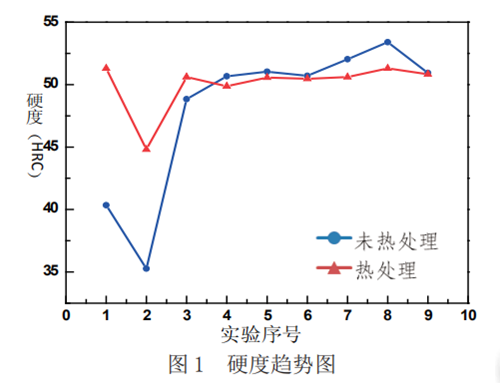Study on production process of low-cost new wear-resistant grinding balls (2)
3.Results and discussion
According to the hardness value and the impact toughness data, the hardness trend charts are drawn: 1; the impact toughness trend Charts as follows: Fig. 2.
Observing Fig. 1, on the whole, the hardness value of 2 # experiment is relatively low, and the hardness value of 3 ~ 9 # experiment is higher, and the change is small, especially after heat treatment (Fig. 1, red curve) the trend of the hardness of 3 ~ 9 # is an almost straight line. Comparing the corresponding points on the two curves, it can be found that the hardness value of the unheated-treated sample is slightly higher than that of the heat-treated sample in 4 ~ 9 # experiment.
Overall, the 9 # test’s impact toughness is better than that of a 1 ~ 8 # test. Comparing the corresponding points on the two curves, it can be found that the impact toughness of heat-treated samples is slightly better than that of non-heat-treated samples. It can be seen that the impact toughness of the samples can be improved by heat treatment in a certain range but to a limited extent. To save power consumption, simplify the working procedure, and reduce manual operation difficulty, heat treatment should not be used.
The results of the two tests show that the performance of the 9 # sample is good, W (C) = 4.5% ー5.5% , W (MN) = 1.5% ー2.0% , and W (CR) = 3.5% ー4.0% can be used for the new grinding ball.
3.3 Metallographic structure
To find out the microcosmic reason for the excellent performance of 9 # experimental sample, this paper analyzes the metallographic structure of 9 # to eliminate the chance. Fig. 3 is a metallographic experiment photo of the unheated-treated sample No. 9—figure 3. As can be seen, the carbides in the samples are mainly network-like, well-distributed, with no obvious impurities. B further amplification can be seen that the main structure of the sample is Ledeburite, with fine needle pearlite and a small amount of massive carbide. The increase of C content is propitious to the samples’ ledeburization, and the Cr element promotes the formation of (CR, Fe)7C3 carbides in the samples, whose shape distribution and hardness are better than those of M22C6 and M3C carbides. At the same time, Mo, CU, and other elements can purify the grain boundary, increase the strength of grain boundary, and improve the impact toughness of samples. Under the action of these factors, 9 # sample has better physical properties.
Fig. 4 is a metallographic picture of the 9 # sample after heat treatment at 350 °C. Compared with figures 3 and 4 respectively, it can be found that the heat treatment process does not change the microstructure morphology of the samples, but the carbide tends to be isolated and dispersed in small pieces by destroying the LEDEBURITE network morphology, the tissue has been refined to a certain extent. When the sample is impacted, such microstructure acts as a buffer to the stress concentration and effectively improves the impact toughness. The metallographic experiment results show that the excellent performance of the 9 # test sample is due to the best composition ratio and reasonable smelting process, making the sample have an ideal structure and eliminating the chance, which provides a basis for the industrial experiment of 9 # test.
Mass production was carried out according to 9 # experimental technology, and an industrial test was carried out on 3.6 ~ 4.0 m wet type 1 # ball mill in the concentrator to determine the adaptability of grinding ball working conditions. The average unit consumption of 1 # ball mill is 0.69 kg/t ore, which is lower than the average level of 0.73 kg/t ore and 0.71 kg/t ore of the same series of 2 # ball mill in the same period. It can be seen that the new type of grinding ball used in the actual working condition has a lower consumption level, no loss of circle, no breakage and even wear after wear, and has better casting quality and comprehensive performance index. The industrial test further proves that the new type of grinding ball’s production process is the best balance point between product cost and product performance.
5.Conclusion
(1) through experimental analysis and industrial test, the optimum composition of the new grinding ball is determined as follows: c 4.5% ー5.5% ; Si 1.4% ー1.6% ; Mn 1.5% ー2.0% ; CR 3.5% ー4.0% ; Mo 0.004% ー0.006% ; Cu 0.003% ー0.005% ; no heat treatment.
(2) the process can save at least CNY155 per ton of grinding ball product, and CNY120 per ton of heat treatment cost, which is CNY275 per ton of grinding ball product. Based on the annual output of 3000 tons, the annual cost can be saved CNY825,000.
(3) the above process method does not need heat treatment, has low requirements for equipment and staff quality, and reduces the cost and staff of workshop equipment purchase and maintenance. The utility model has the technical requirements, and energy consumption is saved.





